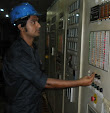Screw type pump
The screw type pump can generate a multitude of frequency components in the vibration spectrum. Thread wear or damage will usually produce strong harmonics of the thread rate, which is the number of threads times the RPM.
 |
| Screw pump |
 |
| screw type pump |
Theory
Screw pumps are a unique type of rotary positive displacement pump in which the flow through the pumping elements is truly axial. The liquid is carried between the screw threads on one or more rotors. The liquid is then displaced axially as the screws rotate and mesh. In other types of rotary pumps, the liquid is forced to travel circumferentially, however the screw pump has an axial flow pattern and low internal velocities
Capacity
The delivered capacity of any screw pump is the theoretical capacity minus the internal leakage. In order to find the capacity of a screw pump the speed of the pump must be known. The delivered capacity of any rotary screw pump can be increased several different ways. The capacity can be increased by simply increasing the speed, increasing the viscosity, or decreasing the differential pressure. The capacity of the pump depends on several factors
- Diameter of the screw
- Speed of the screw
- Number of flights mounted on the screw shaft
-
 Flights: Single, double, and triple flights are often used. Flights are also known as helixes. With each increase in flights, there is a 20% increase in capacity. Therefore, a single flight pump has a capacity that is 80% of a double flight pump, which in turn has a capacity that is 80% of a triple flight capacity. The three-flight pump can handle the most capacity in the least amount of space.
Flights: Single, double, and triple flights are often used. Flights are also known as helixes. With each increase in flights, there is a 20% increase in capacity. Therefore, a single flight pump has a capacity that is 80% of a double flight pump, which in turn has a capacity that is 80% of a triple flight capacity. The three-flight pump can handle the most capacity in the least amount of space.
- Angle of inclination of the screw
- The greater the angle of inclination, the lower the output. The output lowers approximately 3% for every degree increase over a 22 degree inclination.
- Level of influent in the influent chamber
- Ratio of the diameter of the screw shaft to the outside diameter of the screw flights
- Clearance between screw flights and trough
Advantages
- Wide range of flows and pressures
- Wide range of liquids and viscosities
- Built-in variable capacity
- High speed capability allowing freedom of driver selection
- Low internal velocities
- Self-priming with good suction characteristics
- High tolerance for entrained air and other gases
- Minimum churning or foaming
- Low mechanical vibration, pulsation-free flow, and quiet operation
- Rugged, compact design -- easy to install and maintain
- High tolerance to contamination in comparison with other rotary pumps
Disadvantages
- Relatively high cost because of close tolerances and running clearances
- Performance characteristics sensitive to viscosity change
- High pressure capability requires long pumping elements










